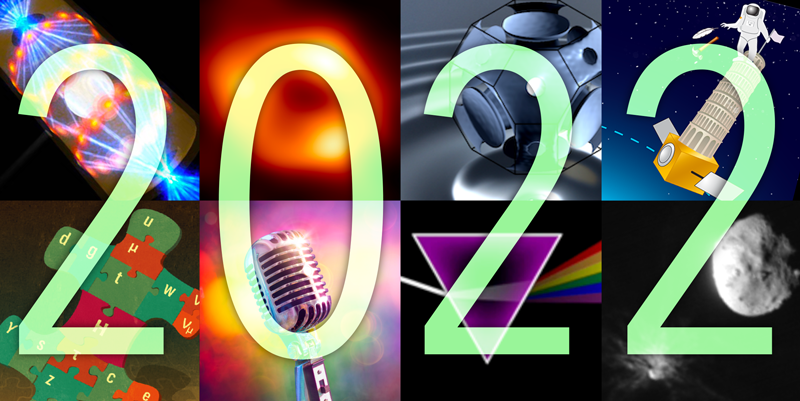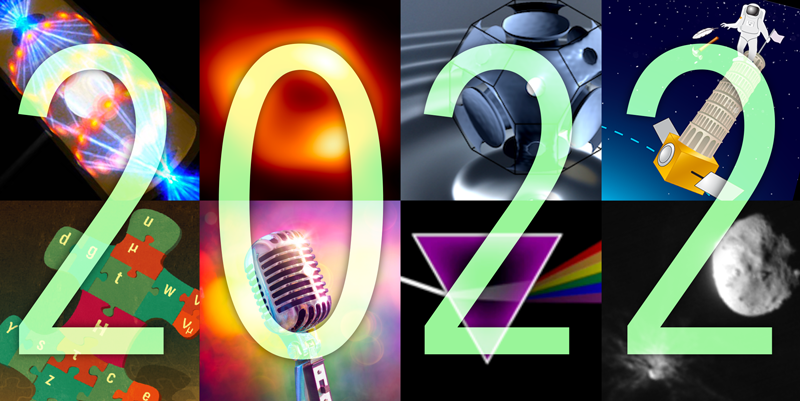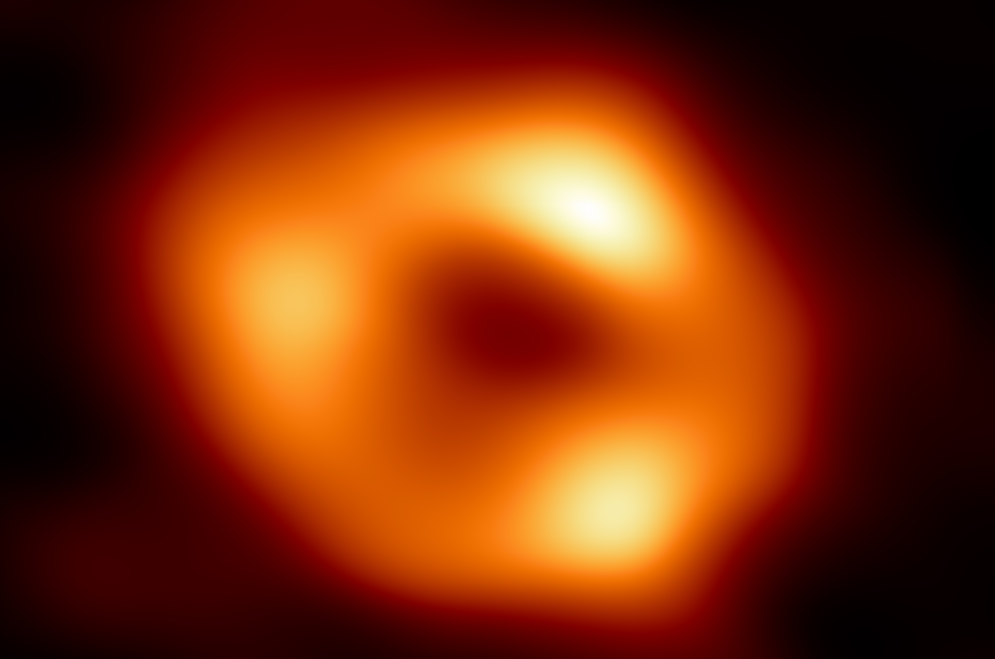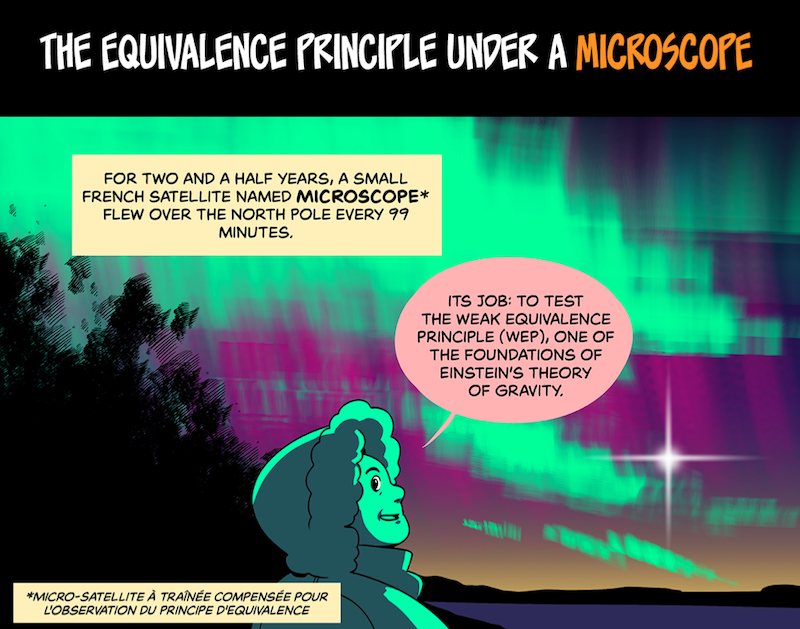Highlights of the Year
With stunning images from the James Webb Space Telescope, breakthroughs in laser fusion, the turning on of an upgraded Large Hadron Collider, and the first test of an asteroid defense system, 2022 provided plenty of grandiose results to cover. There were also important smaller-scale efforts in biological, quantum, and condensed-matter physics as well as invaluable work on diversity, equity, and inclusion that could lead to a more equitable physics community.
Wishing everyone a fantastic 2023!
—The Editors
A Banner Year for Laser Fusion
The year ended on a high note, with the National Ignition Facility achieving a long-awaited milestone. Earlier this year, the team achieved ignition, a self-sustaining burning condition in which local self-heating dominates both external heating and energy loss to the environment (see Viewpoint: Fusion Turns Up the Heat). Last week, the researchers announced that they had already taken the next step—demonstrating a laser-induced fusion reaction producing more energy than it consumed (see Research News: Gaining Ground in Nuclear Fusion). While a practical laser-based fusion reactor remains decades away, the results show that laser-fusion progresses at a pace similar to that of computer development, says Matthew Zepf of the Helmholtz Institute Jena.
Don’t Imagine Quantum Physics is Real
Written into the quantum Schrödinger equation is the imaginary number i, which implies that the solutions to the equation can be complex valued. But are complex numbers just a mathematical convenience? Could a quantum theory be formulated based on real numbers only? Some physicists have indeed argued that a real-valued quantum mechanics can give the same predictions as the traditional one, but at the start of the year the experiments of two independent groups—based on a “game” in which three parties perform Bell-like experiments—suggested otherwise (see Viewpoint: Quantum Mechanics Must Be Complex). The analysis shows that complex numbers are indispensable to describe such experiments, implying that real numbers are insufficient for describing the quantum world as we generally understand it.
The Many Voices of Physics
This year, Physics Magazine launched its new podcast, This is Physics. The first episode reported on the difficulties faced by lesbian, gay, bisexual, transgender, and queer physicists (see Podcast: Life as an LGBTQ+ Physicist). Recent research shows that LGBTQ+ physicists are often shunned or harassed, and these exclusionary experiences can dramatically affect their careers. The interviewed LGBTQ+ scientists shared their personal struggles as well as their positive experiences. They also stressed that improving the climate in physics can be done through shows of support, such as respecting pronouns, offering gender-neutral bathrooms, and being ready to stick up for people who have been treated unfairly.
Milky Way’s Black Hole Comes into View
In May, scientists unveiled the second-ever black hole image. The first, released in 2019, depicted a supermassive black hole over 50 million light years away from Earth. The second showed Sagittarius A*, the black abyss that sits a mere 26,000 light years away from us (see Research News: First Image of the Milky Way’s Black Hole). The task was no mean feat as it involved recovering a full image from snapshots taken by separate telescopes and corrupted by blurring from the movement of gas around Sagittarius A*. To get around these problems, the team developed algorithms that could pick, from thousands of reconstructed images, the image that best fit the incomplete data. “Coming to this conclusion took years, but we never backed away from the challenge,” said Katie Bouman, an engineer at the California Institute of Technology who worked on those algorithms.
More to Come on the Higgs Boson
Ten years after its discovery, nothing about the Higgs boson defies the standard model. But particle physicists believe that studying the Higgs is more important than ever (see News Feature: The Era of Higgs Physics). Knowing how the Higgs interacts with itself and with other particles or finding other Higgs-like particles could help physicists decipher the nature of dark matter or explain the dominance of matter over antimatter. The Large Hadron Collider’s third run, which started in July (see Research News: Good Omens for Run 3), will double the number of Higgs particles available for analysis. “We are truly entering the era of precision Higgs physics,” says Luca Malgeri, spokesperson of the CMS Collaboration, which codiscovered the Higgs.
Two Space Milestones
On July 12th, NASA shared with the world the first images taken by the James Webb Space Telescope, the largest telescope launched into space (see Research News: Iconic Cosmic Images from the James Webb Space Telescope). Exactly three months later, they confirmed that the first demonstration of a tool for planetary defense, which involved slamming a spacecraft into an asteroid, had done what it was meant to: change the orbit of the asteroid (see Research News: Spacecraft Crash Changes Asteroid Orbit by 32 Minutes). While the insights from both missions are still being uncovered, the year will likely go down in the history books as a watershed one for space research.
Deciphering Protein Folding
In the last couple of years, AlphaFold—a machine-learning model—achieved remarkable success in predicting 3D protein structures from their component amino-acid sequences. This year, researchers showed that AlphaFold can also reveal the underlying physical principles that govern the folding process (see Viewpoint: Machine-Learning Model Reveals Protein-Folding Physics). Any given amino-acid sequence could fold in a vast number of ways, and AlphaFold can pick the viable ones from all candidate configurations. The research found that, in doing so, AlphaFold “learns” physical principles such as the so-called energy potential for protein folding. The finding suggests that machine learning can uncover information about complex biomolecular processes that can’t be derived from first principles.
Modern-Day Galileo
At the end of summer, MICROSCOPE—a satellite-based experiment—reported it had verified the equivalence principle with the highest precision yet achieved (see Viewpoint: Satellite Confirms the Principle of Falling). According to this principle, gravitational and inertial masses are fully equivalent and finding discrepancies between the two could reveal beyond-standard-model physics related to mysteries such as dark matter and dark energy. Experiments carried out since Galileo’s times have confirmed the principle with ever increasing sensitivity. Free from the disturbances that affect Earth-bound tests, MICROSCOPE smashed all sensitivity records. By comparing the falling rates of two cylinders made of different materials, it showed that, if gravitational and inertial mass differ, it is by less than 1 part in 1015. Physics Magazine also illustrated the experiment in a cartoon (see Special Feature: The Equivalence Principle under a MICROSCOPE).
Mercury’s Mystery Cracked
Mercury, the first superconductor ever identified, gave up some of its last remaining secrets when researchers developed a theoretical description that can predict the metal’s behavior from first principles (see Synopsis: Explaining Mercury’s Superconductivity, 111 Years Later). The discovery of superconductivity was made in 1911, when physicist Heike Kamerlingh Onnes cooled mercury down to about 4 K. While mercury’s superconductivity was later recognized to be “conventional,” no microscopic theory had been able to accurately describe it. By accounting for subtle and often neglected effects relevant to mercury’s superconductivity, the researchers did just that. The gained insights could be helpful in the material-by-design search of conventional superconductors close to ambient conditions of temperature and pressure.
Clearer Quantum Hearing
A new technique for quickly measuring pairs of quantum mechanically entangled photons led to the demonstration of a quantum optical microphone that outperforms a classical one (see Focus: Hearing the Quantum Difference). In the demonstration, the team encoded a series of words spoken at low volume into optical signals carried by entangled photons, which were then detected and converted to sound recordings. Listeners identified words in these “quantum recordings” more accurately than words recorded with an equivalent classical technique. The researchers say that their demonstration shows the potential of their method for measuring fast, noisy signals, such as those generated by the motions of single molecules in biological cells.









